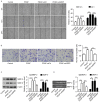Adipose differentiation‑related protein knockdown inhibits vascular smooth muscle cell proliferation and migration and attenuates neointima formation
- PMID: 28713961
- PMCID: PMC5548019
- DOI: 10.3892/mmr.2017.6997
Adipose differentiation‑related protein knockdown inhibits vascular smooth muscle cell proliferation and migration and attenuates neointima formation
Abstract
Vascular smooth muscle cells (VSMCs) have an important role in atherosclerosis development. Evidence has demonstrated that adipose differentiation‑related protein (ADRP) is associated with foam cell formation and atherosclerosis progression. However, to the best of our knowledge, no previous studies have investigated the role of ADRP knockdown in platelet‑derived growth factor (PDGF)‑stimulated proliferation and migration of VSMCs in vitro. Furthermore, the effect of ADRP knockdown on neointima formation in vivo remains unclear. In the present study, primary human aortic VSMCs were incubated with PDGF following ADRP small interfering (si)RNA transfection. Cell viability, migration and cell cycle distribution were analyzed by MTT, wound healing and Transwell assays and flow cytometry, respectively. Extracellular signal‑regulated kinase (ERK), phosphorylated (p)‑ERK, Akt, p‑Akt, proliferating cell nuclear antigen (PCNA), matrix metalloproteinase (MMP)‑2 and MMP‑9 protein levels were determined by western blotting. Apolipoprotein E-/- mice fed an atherogenic diet were injected with siADRP or control siRNA twice a week. After 3 weeks of therapy, aortas were excised and ADRP mRNA and protein expression was determined. Neointima formation was assessed by hematoxylin and eosin staining. The results of the current study demonstrated that ADRP knockdown significantly inhibited PDGF‑induced increases in VSMC viability, caused G1 phase cell cycle arrest and decreased PCNA expression. Knockdown of ADRP inhibited PDGF‑induced migration of VSMCs by reducing MMP protein expression and activity. In addition, the present study also demonstrated that ADRP knockdown inhibited ERK and Akt signaling pathways in response to PDGF. Furthermore, siADRP administration suppressed neointima formation in the mouse model. The results of the present study indicate that ADRP may be a potential target for the treatment of atherosclerosis.
Figures




References
-
- Abu-Fanne R, Maraga E, Abd-Elrahman I, Hankin A, Blum G, Abdeen S, Hijazi N, Cines DB, Higazi AA. α-Defensins induce a post-translational modification of low density lipoprotein LDL that promotes atherosclerosis at normal levels of plasma cholesterol. J Biol Chem. 2016;291:2777–2786. doi: 10.1074/jbc.M115.669812. - DOI - PMC - PubMed
MeSH terms
Substances
LinkOut - more resources
Full Text Sources
Other Literature Sources
Research Materials
Miscellaneous

